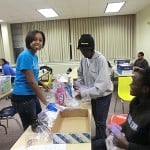The Center for Technology and Training (CTT), a part of the Michigan Tech Transportation Institute (MTTI), hosted the Michigan Bridge Workshop and Conference in Howell, March 20 and 21.
The conference brought together more than 160 engineers and engineering technicians from Michigan County Road Commissions, the Michigan Department of Transportation (MDOT), the Federal Highway Administration, and private firms to learn about bridge design, construction, inspection, funding, and administrative issues related to bridges and new bridge technology.
